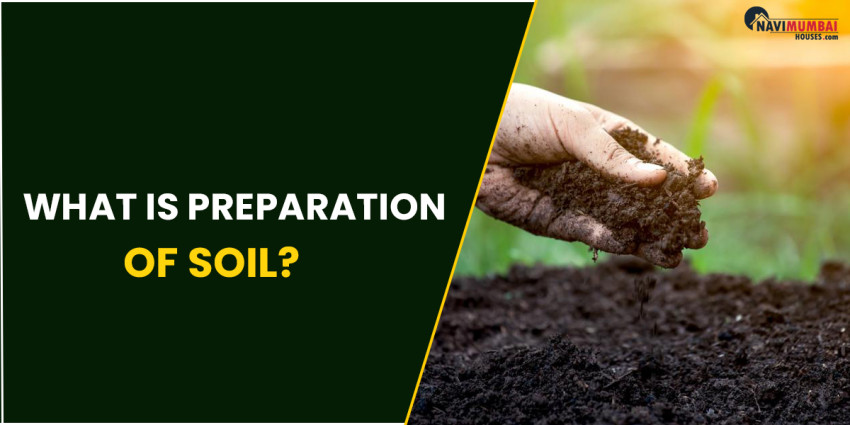
This manual explains the steps involved in soil preparation, the components, and the many types of soil.
The foundation of agricultural output is the soil. Soil is the consequence of a combination of physical, chemical, and biological processes that take place when specific environmental conditions are met. The entire soil is made up of both live and nonliving elements.
The study of soil and edaphic conditions in relation to the cultivation of food and fibre crops is the main objective of the subfield of agricultural soil science. Life on earth is made possible by the intricate admixture of minerals, organic matter, water, air, and other components that make up soil. It is vital to properly prepare the soil before starting to produce crops or scatter seeds.
The process of preparing the soil to grow crops with higher yields and better quality is referred to as soil preparation. This procedure calls for the use of a range of implements, including a hoe, cultivator, and plough, as well as a variety of methods, including ploughing, levelling, and manuring. Since soil is the basis of agriculture, it should be able to cultivate high-quality plants and support the development of a range of crops. Let's examine the steps of soil preparation that are the most important.
Are You Searching 2BHk Flat For Rent In Kharghar?
How is soil prepared : What exactly is soil?
A very significant natural resource is the soil. The thin layer of the earth's surface made up of mineral particles is referred to as soil. These particles were produced by the weathering process, which is the breakdown of rocks, living things, dead organic stuff, water, and air. Pedogenesis is the term used to describe the process of soil formation.
What kinds of soil are there?
India's landscape contains a wide variety of soil types. Alluvial soil, loam soil, red soil, regur (black earth) soil, laterite soil, mountain soil, and others are a few examples of the many different types of soil that exist.
Loam soil is the greatest kind of soil that can be utilised for farming. Loam soil is made up of three different elements: clay, sand, and silt. Among the significant crops that may be cultivated with its assistance are sugarcane, cotton, wheat, jute, legumes, and oilseeds. The development of veggies on this soil is great.
Soil preparation: elements that form up soil
The ground is composed of a vast range of diverse types of constituents. The essential elements of soil are as follows:
Organic substances
The soil's inorganic components are made up of minerals, water, and air.
(a) Minerals: Among other minerals, the rocks that make up the soil contain calcium, potassium, magnesium, iron, and phosphorus. These minerals are found in soils. Each type of rock has its own distinctive collection of naturally occurring minerals.
(b) Air and water: The soil contains pockets of both air and water. Thanks to this air, roots and the organisms that inhabit the soil may breathe more easily. Rainfall and irrigation water will both ultimately permeate the soil. Water is absorbed by the roots, transported up the stems of the plant, and used by the plant's different vital activities.
Organic materials
When microbes decompose dead plants and animals, this substance is created. Another name for this material is humus. It is a very rich nutrient that is essential for plant survival. The main element responsible for the soil's fertility and desirable texture is the presence of humus.
Organisms originating from soil
Numerous microorganisms, such as bacteria, fungus, and others, reside in the soil. They aid in the decomposition of organic compounds, which helps the ecosystem generate humus. Earthworms are sometimes considered to as a farmer's best friend since they help aerate and till the soil.
What exactly does it mean to "prepare the soil"?
Preparing the land for planting is the first step that must be taken before planting a crop. Three of the most important tasks in agricultural production are turning the soil, rotating it, and allowing it to loosen up. The roots are able to delve deeper into the ground because the soil is frequently changed over. The permeable soil allows the roots to quickly absorb oxygen even when deeply buried.
It is possible to get rid of any undesirable plants and weeds when preparing the soil. It is simpler for the plant to grow if there are rows between each plant and space between them.
Soil preparation: Tools used in soil preparation
The three main types of implements used in the process of preparing soil are ploughs, hoes, and cultivators or discs.
This plough
Farmers used the plough, which was a simple piece of farm machinery, in earlier times. It is shaped like a triangle and has a sharp corner. Animals like oxen, bulls, and other similar species are often used for ploughing. This tool's three main parts are the beam, ploughshare, and plough shaft.
What are the procedures for preparing the soil?
Before starting any work on the soil, it is first necessary to have it laboratory-analyzed to ascertain whether or not the soil in a particular area is suitable for agricultural use. The dry earth has to be watered before the field can be tilled. When soil is being prepared, irrigation helps to break up the roots of invasive plants, making it simpler to pick them out of the ground.
The process of preparing soil has three main stages, which are as follows:
Preparing the soil by ploughing or tilling the soil
Tilling or ploughing the soil is the first and most important step in the preparation of the soil. Ploughing is the process of moving the dirt around and breaking it up. Tilling is another term for this practise. A bull is used for ploughing, and it is attached to a beam that is subsequently attached to either a wooden or an iron plough. When ploughing, tractors may also be used to till the ground.
The value of working the land:
(a) It helps loosen the soil, which allows the roots to penetrate deeper into the ground, and it assists the roots in taking in oxygen.
Earthworms, sometimes known as “farmer’s buddies,” and the bacteria that live in the soil both benefit from having the soil loosened up.
(b) The soil contains a wide variety of nutrients, including dead and decomposing organisms, minerals, water, and air, among other things.
(c) In addition to this, it will uproot and bury any weeds that are standing in the field.
After ploughing, levelling the ground
The next step is to use a levelling tool to level the ground. The region that has been tilled may include substantial soil fragments known as crumbs. To break up the dirt lumps, a leveller constructed of iron or wood is required. Not only is the area flattened for seeding, but also for irrigation.
The importance of getting everything even:
(a) To stop the top layer of productive soil from being blown away by high winds or washed away by rains.
(b) To assist in the equitable distribution of water throughout the fields during the process of irrigation.
(c) To reduce the amount of moisture drawn out of the soil.
(d) To achieve better weed management.
Soil fertilisation
Manuring is the process of applying manure to agricultural land in order to fertilise the soil. Plant growth depends on the soil's ability to retain nutrients. It is customary to undertake manure incorporation before to tilling. Dead plants and animal waste (cow dung, goat waste, etc.) are among the organic materials used to make manures.
The importance of manure in agriculture:
(a) A higher crop yield and more fertile soil may be achieved by fertilising and manuring agricultural land.
(b) Manure improves the soil’s texture, recycles nitrogen, and adds microbes necessary for plant growth.
(c) The seeds are nourished by properly combining manure with the soil in the appropriate proportions. The purpose of manuring is to replenish the soil with nutrients and, as a result, to assist in the healthy development of the crop.
The significance of preparing the soil for planting
• By properly preparing the soil, it is simpler to get rid of weeds and aerate the ground.
• It is advantageous to space the seeds at a particular distance apart.
• The addition of fertilisers to soil contributes to the enrichment of the soil's natural nutrients as well as the soil itself.
• The soil is made into a surface that is perfect for direct sowing and a malleable soil mass that may be utilised for transplantation throughout the soil preparation process.
Source From:- navimumbaihouses






